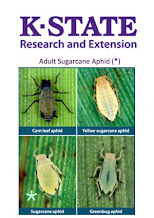Evaluating Your 2020 Wheat Performance and the Post Rock Extension District Wheat Yield Reports
By Sandra L. Wick, Crop Production Agent
Especially thanks to our cooperators for our Post Rock District wheat plots including Art Befort, Calvin Bohnert, Marty Fletchall, and Brent Harzman. The average of the Jewell County wheat plot was 43 bushels/acre and the Smith County wheat plot average was 51 bushels/acre. The KSU replicated wheat plot in Mitchell County averaged 47 bushels/acre. The Osborne County wheat plot was not harvested for yield due to weed pressure.
The use of wheat variety blends is also a big question with producers. Blends can offer producers some yield stability in most cases. While any one variety may do much better or worse than other varieties in the same vicinity, having a blend of two or three varieties can usually even out those ups and downs. Using blends also reduces the chances of having a landlord possibly upset because the variety planted yielded considerably less than other fields in the area.
There are just a few guidelines to remember when using blends. Use varieties with different disease resistance. Although the cost effectiveness of fungicides now may reduce the importance of this factor, there is still value to having at least one natural source of resistance to diseases. Use varieties with slightly different maturities. If producers can spread out the maturity just a bit, there is a better chance that at least one of the varieties can benefit from a given weather pattern. And lastly, don’t be afraid to try new varieties in a blend.
Clearly, the yield potential of a wheat variety is a top priority, but resistance to diseases and insect pests is also an important factor to consider when selecting a wheat variety. Producers are evaluating the performance of their 2020 wheat varieties and considering new varieties they should plant here in a couple of months. The Wheat Variety Disease and Insect Ratings publication from K-State Research and Extension can help growers identify the best varieties for their farms. The publication also provides helpful summaries to help producers better understand the historical risk of diseases in their area and quickly identify the varieties with the best overall disease resistance.
Copies of the 2020 KSU Wheat Variety Disease and Insect Ratings, can be found on-line on our Post Rock District website at https://www.postrock.k-state.edu/crops/ or at any of the Post Rock Extension District Offices.
The Post Rock Extension District had 4 wheat demonstration test plots in our district, including the Mitchell County plot which is an official K-State Research and Extension “replicated” plot which simply means varieties were planted multiply times in one specific area of the field. This particular yield report will be listed in the KSU wheat performance booklet. All of the yield reports are posted on our district website at www.postrock.ksu.edu and are available at any of our Post Rock Extension District Offices in Beloit, Lincoln, Mankato, Osborne or Smith Center. Be sure to also look at the K-State Research and Extension experiment field sites across Kansas with close fields in Belleville and Hays. If you are looking for an opportunity to participate in our Wheat demonstration test plot program, contact me at any of our Post Rock District Offices in Beloit, Lincoln, Mankato, Osborne or Smith Center.
The Post Rock Extension District had 4 wheat demonstration test plots in our district, including the Mitchell County plot which is an official K-State Research and Extension “replicated” plot which simply means varieties were planted multiply times in one specific area of the field. This particular yield report will be listed in the KSU wheat performance booklet. All of the yield reports are posted on our district website at www.postrock.ksu.edu and are available at any of our Post Rock Extension District Offices in Beloit, Lincoln, Mankato, Osborne or Smith Center. Be sure to also look at the K-State Research and Extension experiment field sites across Kansas with close fields in Belleville and Hays. If you are looking for an opportunity to participate in our Wheat demonstration test plot program, contact me at any of our Post Rock District Offices in Beloit, Lincoln, Mankato, Osborne or Smith Center.
Especially thanks to our cooperators for our Post Rock District wheat plots including Art Befort, Calvin Bohnert, Marty Fletchall, and Brent Harzman. The average of the Jewell County wheat plot was 43 bushels/acre and the Smith County wheat plot average was 51 bushels/acre. The KSU replicated wheat plot in Mitchell County averaged 47 bushels/acre. The Osborne County wheat plot was not harvested for yield due to weed pressure.
The use of wheat variety blends is also a big question with producers. Blends can offer producers some yield stability in most cases. While any one variety may do much better or worse than other varieties in the same vicinity, having a blend of two or three varieties can usually even out those ups and downs. Using blends also reduces the chances of having a landlord possibly upset because the variety planted yielded considerably less than other fields in the area.
There are just a few guidelines to remember when using blends. Use varieties with different disease resistance. Although the cost effectiveness of fungicides now may reduce the importance of this factor, there is still value to having at least one natural source of resistance to diseases. Use varieties with slightly different maturities. If producers can spread out the maturity just a bit, there is a better chance that at least one of the varieties can benefit from a given weather pattern. And lastly, don’t be afraid to try new varieties in a blend.
If you have additional questions on selecting wheat varieties contact me at any of the Post Rock Extension District Offices in Beloit, Lincoln, Mankato, Osborne or Smith Center.










